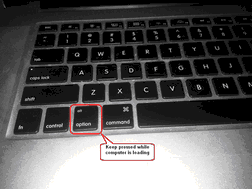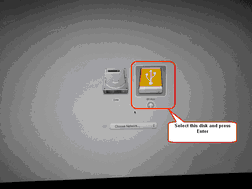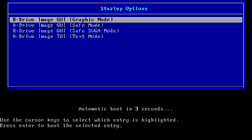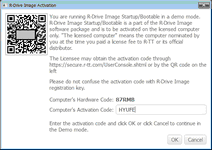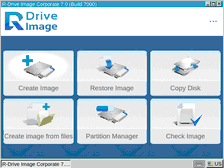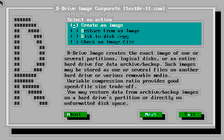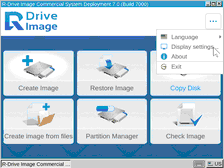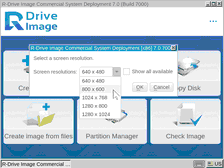


- Contents
- Index
- R-Drive Image
- Disk Actions
- Advanced File Filtering
- RAIDs, and Various Disk and Volume Managers
- Startup Version
- Scheduled Actions, Command Line Operations, and Scripting
-
Technical Information
- Updates
- Cloud Services
- FTP/FTPS Servers
- Network Drives
- Image Replications
- Logging
- Creating Consistent Point-in-Time Backups
- Support for Various Disk Partitioning Schemes and File Systems
- Supported Virtual Disk and Disk Image Formats
- Disk Wiping Algorithms
- Supported CD and DVD Recorders
- List of Hardware Devices Supported in the Startup Mode
- R-Drive Image OEM kit
© 2025 R-Tools Technology Inc.
All rights reserved.
Load Computer into Startup Mode
Sometimes you may need to start your computer into R-Drive Image startup mode, for example, to restore data to a system disk .
You may do that through the following methods:
 If you have a Mac computer...
If you have a Mac computer...
|
The startup version of R-Drive Image can perform basic disk imaging operations for Mac computers. See the Support for Various Disk Partition Schemes and File Systems section for details. To start a Mac computer with the R-Drive Image startup disk, 1. Insert a CD/DVD disc or connect a USB disk 2. Switch the Mac on. 3. While loading, press the Option key on the Mac keyboard (the Alt key if you use a non-Apple keyboard). 4. Select the EFI boot disk and press Enter . |
From the R-Drive Image Graphical User Interface
Note: You cannot use this method if your computer uses UEFI to start up. Use external startup media, like a USB or CD disk instead.
If you try to restart an UEFI computer from the Windows, you'll get a Cannot prepare to reboot... message.
| 1. | Select the file with the image, the object in the image file, select the system disk as the destination as it is described in the Restore Data from an Image topic. Do not pay much attention to the image file, as it will be eventually discarded. The only important option at this stage is the image destination. Select the system disk. |
| 2. | When you click the Next button on the Image Object Selection panel, the Disk not locked message will appear. |
| 3. | Select Restart computer (recommended) and click the OK button. The You are about to restart... message will appear. Click the Yes button. (If you click the Cancel button on the Disk not locked message, the Cannot lock the disk message will appear, and R-Drive Image will stay on the Image Object Selection panel.) |
You computer will restart. The following text will appear on the screen:
|
Please select the operating system to start:
R-DriveImage Autopart v.2.0 Microsoft Windows XP Professional |
| 4. | Select R-DriveImage Autopart v.2.0 and press the Enter button. You may select Microsoft Windows XP Professional to start Windows normally. |
using the R-Drive Image startup USB disk or CD disc
| 1. | Make sure that the first startup device in the system BIOS is the required drive. If you are going to use the Linux-based startup disk, disable " Secure boot " in the system BIOS if your computer is certified to run Windows 8 and later. Refer to your system documentation for details. The WindowsPE-based disk doesn't require this step. |
| 2. | Connect the USB disk or insert the CD disc and start your computer. |
R-Drive Image will start in the startup mode.and a startup screen will appear:
Select the R-Drive Image GUI (Graphic Mode) to run R-Drive Image in the graphic mode in which its user interface is similar to the Windows version. if R-Drive Image cannot run in this mode, restart the system in the Safe VGA mode (only VESA-compliant) which is compatible with most video cards and monitors. If it fails too, select the Text mode in which the R-Drive Image user interface is shown in the pseudo-graphic mode compatible with all video cards. The help below describes this pseudo-graphic mode.
Use the Tab key to switch between the control areas and the arrow keys to select options within the control areas. Press the Enter key to activate the selected button.
You may also activate a key by pressing the highlighted letter key. You may exit the program by pressing the x key.
Before R-Drive Image starts working, it will require activation. An activation window will appear.
You need to enter a Computer Activation Code to proceed further. You may obtain it by either going to User Console on another computer or by scanning the QR-code by your phone.
Please note that some license restrictions may apply. The License Transfer help page explains them in detail.
When the Action Selection panel will appear.
Specifying video settings for the GUI startup version.
You may specify video screen resolution when necessary.
| 1 | Select Display settings in the shortcut menu |
| 2 | Select the required screen resolution and click the OK button |
- R-Studio Technician: activation using a USB stick
- Data Recovery Guide
- Why R-Studio?
- R-Studio for Forensic and Data Recovery Business
- R-STUDIO Review on TopTenReviews
- File Recovery Specifics for SSD devices
- How to recover data from NVMe devices
- Predicting Success of Common Data Recovery Cases
- Recovery of Overwritten Data
- Emergency File Recovery Using R-Studio Emergency
- RAID Recovery Presentation
- R-Studio: Data recovery from a non-functional computer
- File Recovery from a Computer that Won't Boot
- Clone Disks Before File Recovery
- HD Video Recovery from SD cards
- File Recovery from an Unbootable Mac Computer
- The best way to recover files from a Mac system disk
- Data Recovery from an Encrypted Linux Disk after a System Crash
- Data Recovery from Apple Disk Images (.DMG files)
- File Recovery after Re-installing Windows
- R-Studio: Data Recovery over Network
- How To Use R-Studio Corporate Package
- Data Recovery from a Re-Formatted NTFS Disk
- Data Recovery from an ReFS disk
- Data Recovery from a Re-Formatted exFAT/FAT Disk
- Data Recovery from an Erased HFS Disk
- Data Recovery from an Erased APFS Disk
- Data Recovery from a Re-Formatted Ext2/3/4FS Disk
- Data Recovery from an XFS Disk
- Data Recovery from a Simple NAS
- How to connect virtual RAID and LVM/LDM volumes to the operating system
- Specifics of File Recovery After a Quick Format
- Data Recovery After Partition Manager Crash
- File Recovery vs. File Repair
- Data Recovery from Virtual Machines
- How to Connect Disks to a Computer
- Emergency Data Recovery over Network
- Data Recovery over the Internet
- Creating a Custom Known File Type for R-Studio
- Finding RAID parameters
- Recovering Partitions on a Damaged Disk
- NAT and Firewall Traversal for Remote Data Recovery
- Data Recovery from an External Disk with a Damaged File System
- File Recovery Basics
- Default Parameters of Software Stripe Sets (RAID 0) in Mac OS X
- Data Recovery from Virtual Hard Disk (VHD/VHDX) Files
- Data Recovery from Various File Container Formats and Encrypted Disks
- Automatic RAID Parameter Detection
- IntelligentScan Data Recovery Technology
- Multi-pass imaging in R-Studio
- Runtime Imaging in R-Studio
- Linear Imaging vs Runtime Imaging vs Multi-Pass Imaging
- USB Stabilizer Tech for unstable USB devices
- Joint work of R-Studio and PC-3000 UDMA hardware
- Joint work of R-Studio and HDDSuperClone
- R-Studio T80+ - A Professional Data Recovery and Forensic Solution for Small Business and Individuals Just for 1 USD/day
- Backup Articles
- R-Drive Image Standalone and Corporate license transferring
- Fixing Windows update error 0x80070643 with R-Drive Image
- Backup with Confidence
- R-Drive Image as a free powerful partition manager
- Computer Recovery and System Restore
- Disk Cloning and Mass System Deployment
- Accessing Individual Files or Folders on a Backed Up Disk Image
- R-Drive Image startup / bootable version
- File Backup for Personal Computers and Laptops of Home and Self-Employed Users
- Creating a Data Consistent, Space Efficient Data Backup Plan for a Small Business Server
- How to Move the Already Installed Windows from an Old HDD to a New SSD Device and Create a Hybrid Data Storage System
- How to Move an Installed Windows to a Larger Disk
- How to Move a BitLocker-Encrypted System Disk to a New Storage Device
- How to backup and restore disks on Linux and Mac computers using R-Drive Image
- Undelete Articles
- Get Deleted Files Back
- Free Recovery from SD and Memory cards
- R-Undelete: Video Recovery
- Recovery from an External Device with a Damaged File System
- File recovery from a non-functional computer
- Free File Recovery from an Android Phone Memory Card
- Free Photo and Video File Recovery Tutorial
- Easy file recovery in three steps


